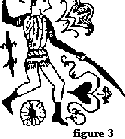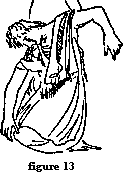 Celtic Clothing
Celtic Clothing
 Celtic Clothing
Celtic Clothing
The oldest depictions of Celtic clothing come from the Hallstatt period (around 500 b.c.) from the area of modern Austria. Several men are shown on a decorative scabbard plate (Fig. 1). They are wearing tight fitting pants, a tunic that resembles a cutaway coat and shoes with upturned toes. These early Celts were on the border of a Scythian lands and their outfits may show Scythian influence. Stylized women's figures from the same time show them wearing highly decorated skirts or tunics but because of the nature of the drawings, no definite construction can be determined. (Fig. 2). Remains of clothing from a Celtic chieftain's grave at Hochdorf (also Halstatt period) shows pants worn with a tunic and shoes with pointed toes. An unusual find was a conical hat of birch-bark decorated with fine punched patterns. Preserved bodies of Halstatt salt miners show the same type of clothing on a less grand scale with conical hats of animal fur. Celt-Iberic (Celts from what is now modern Spain and Portugal) men are shown wearing tunics of mid-thigh length with a wide decorated belt at the waist (Figure 3). Celt Iberian women wore elaborate headdresses and tunics with checkered trim, and sometimes flounces at the hem (Figure 4).
To my knowledge, there are no depictions of dress in Ireland before the Christian period. Therefore we must rely on literature from that period which was passed down through oral tradition until Christian times, or on Celtic depictions from the continent. Spain provides a fertile ground because of the large amount of commerce between the two areas. The Book of Leinster, written down in the 9th century, is the major source of descriptions. It contains the Tain bo Culange or Cattle Raid of Cooley which is especially descriptive. Clothing for the early Irish of all ages and sexes consisted of a linen or in some cases silk tunic (the leine) and a four-cornered or oval cloak (the'brat') worn over it. An analysis of the clothing worn in "the Arraying of the host' from the Tain showed that of the 37 warriors described, most wore some kind of shirt. Eight were silk, with linen mentioned once, although this may have been because it was a foregone conclusion, since most tunics are known to have been made of linen. Indeed the word leine means linen. The tunics were usually white in color, although dark gray, gold, yellow and a brown-red 'soldier's tunic' are mentioned. Three were described as sleeved, four as hooded, three as knee-length, one as calf-length. The common length was probably mid-thigh for men as were those of the Celt Iberians. Of the Tain leine, seven had red gold embroidery as trim, one had lace (probably a type of trim, not lace as we think of it), one had a gold hem, three had gold seams and two had red embroidery. Other sources mention the use of the 'corrthar' or fringe for trimming. Many costumers mistakenly put intricate interlace on early Celtic costumes. Until the 5th century or later, the interlace used was the simple "dirk's handle" twist (figure 5).
The brat could be either worn over the shoulders or wrapped several times around the body. In either case, it was pinned at the breast with a pin or brooch. The length of the brat was related to the status of the wearer. The longer the brat, the higher the status. The brat of kings and heroes was often referred to as being 'five-folded'. Mantles from the Tain were purple (4), green (4) reddish-gray, black, and gray streaked (2 each), yellow, red, dun, purple edged (a toga??), pieced (patchwork??) and red-brown (1 each). Mention is often made in later literature of Irish cloaks resembling bear skins or fur. A piece of a cloak from the early Christian period with inserted tufting s of wool has been found in an Irish bog. The Tain mentions two cloaks as being "curly wool".
 |
 |
 |
 |
 |
A belt of leather or wool called the oriss was sometimes worn over the leine, although the Tain only mentions belts in connections with swords or armor. Belts worn by the Celt Iberians of this period were wide and decorated with metal plaques.
Shoes or sandals were of leather or sometimes linen and colors mentioned are purple and yellow. shoes are described as being worn only by women or druids so they probably didn't form part of the gear of a fighting man. Interesting one piece shoes have been found in the Irish bogs and they are of the same type worn by figures in the Book of Kells. we are currently working on a useable pattern for that shoe and it will appear in a future issue.

Hats are not mentioned often, but headbands of cloth or gold are worn by some characters, with charioteers being described as wearing gold ones.
Women's clothing is not described as often or in such detail in the 'Tain' as that of fighting men. Feildelm the Prophetess wore a green speckled cloak with a round, heavy headed brooch above her breast when she appeared to Maeve. "The Wooing of Etain" describes her clothing as "...a tunic she wore with a long hood that might cover her head attached to it; it was stiff and glossy with green silk beneath red embroidery of gold and was clasped over her breasts with marvelously wrought clasps of silver and gold...". She wore a purple cloak with this. The hood mentioned in this instance, as well as for the men above, may not have been a true hood but rather a fold of material at the top of the tunic (fig. 6) as seen on early Greek chitons. The dresses are also described as being "tight-fitting" which the early Greek chitons were. Some authors mention the wearing of bells on the hems of the dresses.


By the Viking period, soldiers and lower class males wore a jacket (ionar) and trews (pants or hose). There were three types of trousers--baggy and gathered just below the knee to fit snugly, knee length and tight fitting, or long and tight fitting with a strap passing under the instep (fig. 7). There is no evidence that the Irish ever used cross-gartering on their hose as did the Germanic tribes.
Leine shown in the Book of Kells are ankle length except for those worn by warriors (fig. 8). Upper class warriors and younger men seem to have stuck to the older dress forms.
The upper classes beyond the Pale (the zone of English influence) continued to wear the linen leine until well past the SCA period. The leine did become much fuller and developed long full sleeves. Later periods rinsed their washed leine in saffron water which the English said helped kill the lice.
By Roman times, the Celts on the European continent as well as those in Britain bore such a resemblance to their Germanic neighbors that the Romans differentiated them by language. The men wore trousers in many forms. They could be tight fitting and extending just over the knee like those on the Gundestrup cauldron (fig. 9). These were adopted by the Roman legions in the northern provinces and were called 'femoralia'. Other styles were looser fitting and either had feet in them or were secured at the ankles by being tied down with the straps from their shoes. The trousers either had a tie at the waist or were furnished with belt loops (figure 10). Shirts were either the basic t-tunic type or sleeveless. The Celtic prisoners on 'Trajan's column' wore tunics with fringed hems (fig. 11). Shoes varied but for the m most part were one piece leather similar to those in EP issue #1, although Gaulish sandals and shoes constructed of straw have been found (fig. 12). Cloaks were rectangular or ovoid; the oval ones being shaped on the loom. Some Roman depictions show Celtic men wearing caps and hats similar to a Shriner's fez but rounded on top.
 |
 |
 |
 |
 |
|||
One type of women's clothing was the narrow tunic or chiton. some tribes are described as wearing white ones with purple embroidery. The best depictions are from Trajan's column and the Greek statue of the Celtic warrior who has killed his wife and is in the process of killing himself rather than be captured. (fig. 13) Other period sources show knee length chitons with long sleeved tunics or ankle length chitons underneath. The Mater figures in northern Germany show over-dresses fastened at the breast with a pin (fig. 14).
Another form of clothing was the short tunic tucked into a long skirt. This was probably adopted form neighboring Germanic tribes, as it seems to have been the costume of the Ostrogothic women (fig. 15).
Continental Celtic clothing was made of wool or linen with occasional references to silk. As they became more Romanized, the clothing swung more toward Roman fashions with an increase in luxury fabrics.
 |
 |
 |